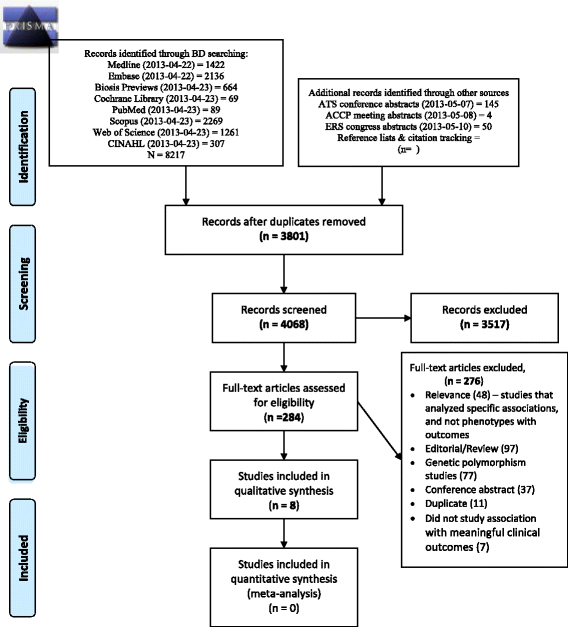Derivation and validation of clinical phenotypes for COPD: a systematic review
- PMID: 25928208
- PMCID: PMC4460884
- DOI: 10.1186/s12931-015-0208-4
Derivation and validation of clinical phenotypes for COPD: a systematic review
Abstract
Background: The traditional classification of COPD, which relies solely on spirometry, fails to account for the complexity and heterogeneity of the disease. Phenotyping is a method that attempts to derive a single or combination of disease attributes that are associated with clinically meaningful outcomes. Deriving phenotypes entails the use of cluster analyses, and helps individualize patient management by identifying groups of individuals with similar characteristics. We aimed to systematically review the literature for studies that had derived such phenotypes using unsupervised methods.
Methods: Two independent reviewers systematically searched multiple databases for studies that performed validated statistical analyses, free of definitive pre-determined hypotheses, to derive phenotypes among patients with COPD. Data were extracted independently.
Results: 9156 citations were retrieved, of which, 8 studies were included. The number of subjects ranged from 213 to 1543. Most studies appeared to be biased: patients were more likely males, with severe disease, and recruited in tertiary care settings. Statistical methods used to derive phenotypes varied by study. The number of phenotypes identified ranged from 2 to 5. Two phenotypes, with poor longitudinal health outcomes, were common across multiple studies: young patients with severe respiratory disease, few cardiovascular co-morbidities, poor nutritional status and poor health status, and a phenotype of older patients with moderate respiratory disease, obesity, cardiovascular and metabolic co-morbidities.
Conclusions: The recognition that two phenotypes of COPD were often reported may have clinical implications for altering the course of the disease. This review also provided important information on limitations of phenotype studies in COPD and the need for improvement in future studies.
Figures

References
-
- Vogt W, Nagel D. Cluster analysis in diagnosis. Clin Chem. 1992;38:182–98. - PubMed
Publication types
MeSH terms
LinkOut - more resources
Full Text Sources
Other Literature Sources
Medical

